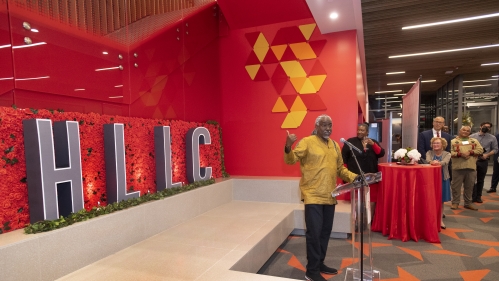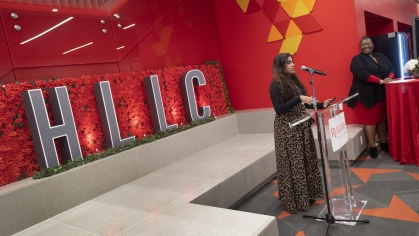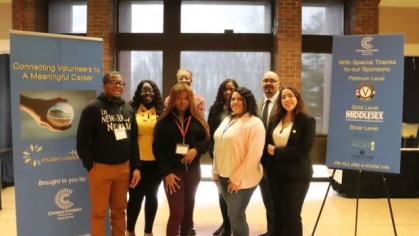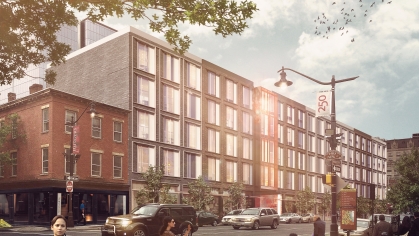Rutgers-Newark Celebrates Groundbreaking Honors Program with Grand Opening

The Honors Living-Learning Community (HLLC) at Rutgers University–Newark last week celebrated the grand opening of its new building, a major milestone in the mission to cultivate future scholars and leaders whose vast potential might otherwise be overlooked.
At a ceremony filled with music and an ongoing art installation by student Ana Monteiro, which honored the history of the site as the original home of Native Americans and the 19th-century Halsey Street Episcopal Church, the facility was hailed as a marriage of form and function.
“This building perfectly exemplifies the seamless relationship between physical infrastructure and social infrastructure. It demonstrates how much space and place can invite intellectual and cultural and social interaction. You build it and they will come—and make a difference in the world," said Rutgers-Newark Chancellor Nancy Cantor. “We wanted to make this a meeting place, a center of innovation, dialogue, debate and collaborative learning.”
She reminded students at the event that the HLLC was created for them and their dreams of building a more equitable world. “You make real what it means to celebrate the lived experiences of our students, the next generation of changemakers, doubling down on social justice,’’ she said.
Created in 2015, the Rutgers-Newark HLLC is an intergenerational learning and residential community that enrolls scholars ranging in age from 18 to 60. They encompass a diversity of experiences, including first-generation college students, transfer students and those who are parents. Half are from the city of Newark. The program has been recognized nationally for reimagining honors programs, including the use of an in-depth holistic admissions process to identify exceptional students.
The 320,000-square-foot HLLC building, located on New Street, can house 390 students and includes a range of learning and meeting areas designed to foster conversation. The Global Piazza between Halsey and Washington Streets features a variety of illuminated words in 20 languages and is open to the public. It will be bordered by street-level shops, eateries, gallery space and facilities to support urban entrepreneurship.
At the ceremony, Rutgers University President Jonathan Holloway praised the HLLC as the embodiment of American ideals. “It speaks to what drew me to Rutgers. It represents the democratic possibilities of this country, a place that draws together people from different races, ethnicities, economic situations, neighborhoods and communities and exposes them to life changing opportunities.’’
He added, “Excellence can be found everywhere. We just need to look for it, find it and nurture it. We know from looking around this room that seeking and cultivating talent produces amazing results.’’
HLLC Dean Timothy Eatman extolled the importance of diversity. “The notion of diversity swirls within this place, and we will make sure that these scholars don’t forget it,’’ he promised.
He noted that one goal of the HLLC was to ensure that it is replicated beyond the city, a process that is underway as other schools in the U.S. have shown interest in incorporating aspects of the program. He quoted the chancellor. “She said it was insufficient for it to just be in Newark.’’
Two HLLC students and a graduate also spoke at the event.
Spoken word artist Sherish Taqueen described the HLLC as a catalyst for creativity and intellectual excitement. “It encouraged every idea and soon the ideas began to overflow,’’ she said. “The journey you begin here is one that is endless.’’
Veronica Torres, a Criminal Justice major, described a sense of belonging and security. “I have never been so supported in a space as I am in this building.’’
Graduate Ty-Lynn Johnson, a Rutgers Business School alumnus and now an investment analyst at Black Rock, said support from his HLLC network helped him overcome self-doubt and seize opportunity. As he struggled against “imposter syndrome,’’ an HLLC friend encouraged him. “He said, ‘you need to be in that seat, because if you’re not, more of you will never get in that seat.’’’
In addition to the speakers, there were musical performances by a drum group led by Timothy Ogunbiyi, and Melaine R. Hill, an assistant professor of American Literature in the Department of English and nationally renowned gospel violinist. Vincent Mann, Turtle Clan Chief of the Ramapough Lenape Nation, gave a “land acknowledgement’’ to open the ceremony. Shane Harris, Prudential Financial vice president for social responsibility and president of the Prudential Foundation, also gave remarks highlighting their gift to the HLLC to create the Prudential Scholars Program as a signature investment made in the future of Newark.
The Prudential Scholars Program is supported through a $10 million gift to the Pro-Social Entrepreneurship Pathway, an HLLC academic program that includes the Urban Solutions Lab, where students explore ways to remake urban America with a special focus on efforts within Newark. The lab is also supported by the PSE&G Foundation. The Science, Technology, Engineering, Arts, and Math (STEAM) Pathway, an additional program supported by the PSE&G Foundation, provides opportunities to integrate science across disciplines.
The Price Humanities Scholarship Program, created with funding from the Mellon Foundation, fosters the next generation of humanities scholars. The Rutgers-Newark BOLD Women’s Leadership Network, launched with support from the Helen Gurley Brown Foundation, helps women HLLC scholars develop leadership skills and pursue career objectives.
Also supporting academic programs within the HLLC space is Fiserv, Inc. which is funding the Fiserv-RU-N Program for Inclusive Innovation, an effort that will serve as a research and incubation space for the RU-N community and local businesses, in addition to providing RU-N student scholarships. The program center is located on the ground floor of the HLLC building, bordered by the piazza.
Gifts from Bank of America and the Charlotte W. Newcombe Foundation support HLLC transfer students.


